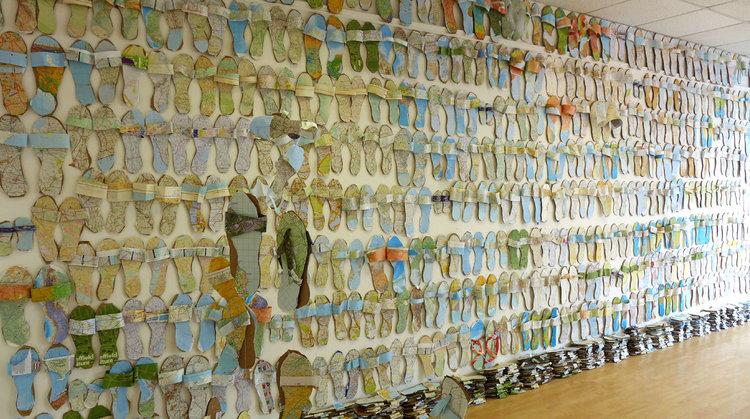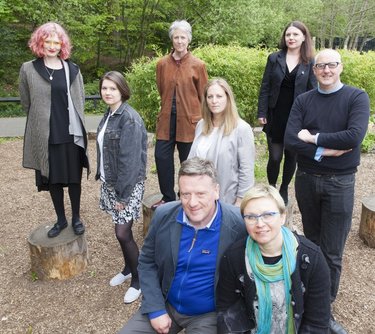Exhibition | Migration – From Burdens to Opportunities
For many people of my generation, 1989 was a defining year. The geopolitical map of the world shifted and the post-World War II, tripartite Cold War arrangement came to an end. As the Iron Curtain lifted, and the ideological rivalry of communism and capitalism expired, there was a short-lived moment when we all believed that we could live free from the hegemony of any systems. There was a sense of euphoric freedom and plenitude of possibilities. But as neoliberal capitalism dawned upon us, and the West claimed its status of the “first world”, whose economic, technological, political, and epistemological infrastructure of power were hailed as victorious, the ‘East’ soon emerged as ‘former’, or secondary. The world order was quickly redefined and a new hierarchy established. Citizens of the East, like myself, who looked up to the West and longed for its privileges, soon learnt that they weren’t really part of the package. Positioned outside of EU structures, we fell into a secondary category of citizenship where freedom of movement and access to the labour market remained restricted. This act of exclusion made us different, and once again the nagging longing to be truly ‘Western’, or simply equal, took hold.
[perfectpullquote align=”left” cite=”” link=”” color=”#8BD616″ class=”” size=””]Living abroad and immersing oneself in a new culture often creates a sense of displacement, challenging one’s notion of identity and belonging.[/perfectpullquote]Two decades on, my personal story is very different. Granted the official status of European citizen in 2004, I was part of the massive migration movement that took place in the mid- to late 2000s and saw thousands of Eastern Europeans leave their motherland to try their luck somewhere else. Some of us moved countries because of financial circumstances, others out of pure curiosity to live elsewhere. This sudden influx of new nationals transformed some of the previously homogenous European countries into multicultural metropolises, Ireland being a particularly strong example. Its social landscape was inadvertently changed between 2004-2006, when it reportedly welcomed nearly 100,000 new immigrants per year. Was it an easy adjustment for either of the parties? I doubt it… I remember arriving in Dublin only to realise that my previous professional experience wasn’t immediately acknowledged and valued. Despite working in my field for many years, I had to start at the bottom, building my professional credibility and network from scratch. I went back to college and did another degree in order to speed up the process of assimilation.
This experience isn’t necessarily unique to foreign nationals. Many migrants with Irish nationality, returning to the country after years of absence, find themselves, too, in a new and unfamiliar environment. Living abroad and immersing oneself in a new culture often creates a sense of displacement, challenging one’s notion of identity and belonging. There is a sense of a gap that cannot be bridged and with it often comes the accompanying feeling of alienation.

Currently in its fifth edition, the New Voices of Ireland Series was founded as an acknowledgement of and response to such complexities of migration. Monika Sapielak and Ian Oliver, who run the Centre for Creative Practices and for whom Ireland, too, is home by choice, are its founders. They not only understood the complex nature and challenges that come with the emergence of cultural diversity in this previously homogenous society, but also recognised the urgent need for mediation between migrants and local communities to allow for integration and cross-pollination of ideas. Using their expertise in the field of cultural production, Sapielak and Oliver created a public platform for artists to address urgent social issues, and in doing so connect them to local groups and facilitate the necessary exposure. In the past five years, over one hundred artists engaged with over sixteen thousand members of the public through participatory and collaborative practices addressing Ireland’s most pressing social problems.
This year’s edition is particularly timely. Titled ‘Migration – from Burdens to Opportunities’, it looks closely at migration in the context of the recent rise of xenophobia and alt-right movements. It presents the collaborative works of: Mark Lawlor (UK), El Putnam (US), Eleanor Lawler (IE), Kiera O’Toole (IE), Mirjana Reneduzic (HR), Olga Dziubak (PL), and Csilla Toldy (HU). Though all the selected artists are now Irish residents, some are only here in passing while some have been living here for many years and intend to stay. Some, like Lawler and O’Toole, returned after a period of time abroad and are re-learning to live and navigate the Irish way of life. Each artist has personally experienced and entered the cycle of migration that feeds into the project. It was fascinating to listen to their personal stories during the early workshop meetings: choices they made, the reasons why they made them, and how they influence their artistic practice. But all in all, we knew we were the lucky ones. I have this sentence written down in my notes from the meeting: ‘Unless you look like a migrant, you’re not a migrant’, which crudely sums it up. Geographical positioning, the place of one’s birth, determines one’s life and the opportunities that come with it. We were all born in the right place. There was no particular sense of limitation or restriction in our set of circumstances. We discussed the distinctions between being ‘legal’ or ‘illegal’, ‘migrant’ or a ‘refugee’ and the privilege of being simply an ‘expat’. This terminology clearly determines opportunities that are given to us – be it education, work, access to healthcare or food.

In light of the current refugee crisis and the rise of xenophobia and hatred around the world, it is worth reminding ourselves that there are still many people who feel like second-class citizens on a regular basis. They were born in the ‘wrong’ country or with what can be perceived as the ‘wrong’ skin colour. They experience discrimination and abuse and are often afraid to keep their heads high. They cannot access the opportunities which we perceive as being our constitutional rights. We don’t have to look far; EU agencies such as Frontex have been established to reinforce the borders between EU and non-EU countries, thus creating a new East/West division. For us, European citizens, the world has shrunk, while for those positioned outside the privileged structures, the gap between the two worlds is as big as ever.
The final shows will take place in Dublin on Sat the 16th Sep during the Bluefire Streetfest in Smithfield, Dublin 8, from 2-8pm and during Culture Night on Fri the 22nd Sep in the Dublin Institute of Design, 45 Kildare Street, D2. For further information visit the Centre for Creative Practices website or contact [email protected]
Featured Image: El Putnam
